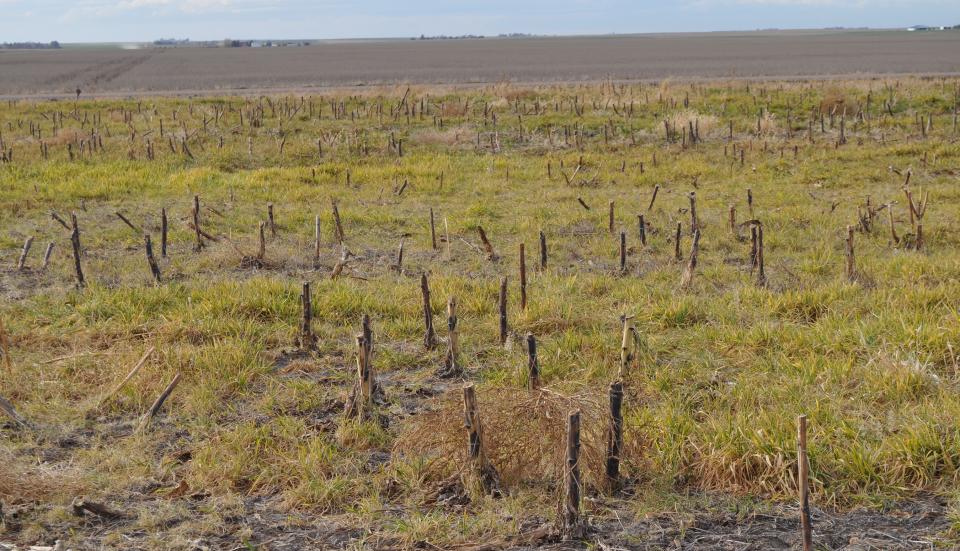
Figure 1. Severe symptoms of wheat streak mosaic in volunteer wheat in sunflower stubble in Deuel County in November 2016. Such a field significantly increases the risk of infection of wheat in nearby fields. (Photo by Gary Hein)
Growers Urged to Keep a Watchful Eye for Wheat Viruses This Spring

Nebraska wheat conditions were very good going into winter. However, disease and weather conditions can cause wheat to winterkill, leading to poor stands and lower yields. Farmers should plan to scout their fields carefully in the spring.
A mild fall and ample moisture at planting allowed winter wheat in the Panhandle to establish with good stands. Some areas near Ogallala and Grant suffered from dry conditions later in the planting season and wheat was slow to emerge.
Recent snowfall has eased concerns about dry soil conditions that persisted late into November. As of Jan. 23, the winter wheat appeared to be wintering well. However, a lot can change before spring, and winterkill is still a possibility.
Potential Overwintering of Virus Vector
While the mild fall promoted wheat establishment, it also favored survival of wheat curl mites that serve as vectors for viruses.
Wheat streak mosaic, wheat mosaic (High Plains), and Triticum mosaic viruses are spread to wheat by infected mites. Virus risk to new-crop wheat depends on the mites’ ability to find alternate “green bridge” hosts to survive from wheat harvest into the fall, when they will move to the new crop.
The highest risk green bridge host for the mite is volunteer wheat emerging before wheat harvest, usually as the result of a pre-harvest hail event. However, volunteer wheat emerging pre-harvest occasionally can be found in summer crops, such as sunflower or proso millet (Figure 1). Other potential, but less risky, summer hosts include corn, foxtail millet, or summer annual grass weeds such as green foxtail and barnyardgrass.
Wheat samples collected from fields showing virus symptoms (yellowing and stunting, Figure 2) in November 2016 in the Nebraska Panhandle tested positive for wheat viruses. These viruses have the potential to significantly reduce yields in hardest hit fields.
| Field1 | WSMV2 | TriMV3 | HPV4 | WSMV and TriMV | WSMV and WmoV5 | Triple Infections |
|---|---|---|---|---|---|---|
| South 1 | 7/10 | 0/10 | 0/10 | 0/10 | 0/10 | 0/10 |
| South 2 | 10/10 | 6/10 | 8/10 | 2/10 | 4/10 | 4/10 |
| South 3 | 10/10 | 10/10 | 6/10 | 4/10 | 0/10 | 6/10 |
| South 4 | 10/10 | 1/10 | 8/10 | 1/10 | 8/10 | 0/10 |
| South 5 | 4/4 | 3/4 | 0/4 | 3/4 | 0/4 | 0/4 |
| North 1 | 0/5 | 0/5 | 1/5 | 0/5 | 0/5 | 0/5 |
| North 2 | 3/5 | 0/5 | 2/5 | 0/5 | 2/5 | 0/5 |
| North 3 | 0/5 | 0/5 | 1/5 | 0/5 | 0/5 | 0/5 |
| North 4 | 1/5 | 0/5 | 0/5 | 0/5 | 0/5 | 0/5 |
| North 5 | 0/5 | 0/5 | 0/5 | 0/5 | 0/5 | 0/5 |
| North 6 | 0/5 | 0/5 | 0/5 | 0/5 | 0/5 | 0/5 |
| North 7 | 0/5 | 0/5 | 0/5 | 0/5 | 0/5 | 0/5 |
| 1 South fields were sampled near Chappell; North fields were sampled west of Hemingford. 2 WSMV = Wheat streak mosaic virus 3 TriMV = Triticum mosaic virus 4 HPV = High Plains (Wheat mosaic) virus 5 WMoV = Wheat mosaic Virus | ||||||
Fields sampled north of Chappell, where an extensive pre-harvest hail storm occurred, had typical virus symptoms of general yellowing and stunting and tested positive for at least one virus (Table 1). In the area west of Hemingford in the northern Panhandle, four of seven fields tested positive for wheat streak mosaic virus or wheat mosaic virus, but at a much lower incidence (percentage of samples testing positive) than in the southern Panhandle (Table 1).
The sooner after fall emergence that winter wheat is infected, the greater the impact of the viruses on yield. Significant yield reduction or total loss can result if wheat is infected early and displays severe symptoms in the fall. The yield impact on wheat infected in late fall or in the spring will be much less.
Recommendations
In the spring growers should actively scout their wheat fields. Termination of the wheat crop should be considered in severely impacted fields with low or no yield potential.
Prior to termination, growers should work with their crop insurance representative to ensure proper documentation is completed. After termination the field could be fallowed or planted to another crop, assuming the herbicides used do not restrict crop rotation.
Online Master of Science in Agronomy
With a focus on industry applications and research, the online program is designed with maximum flexibility for today's working professionals.
